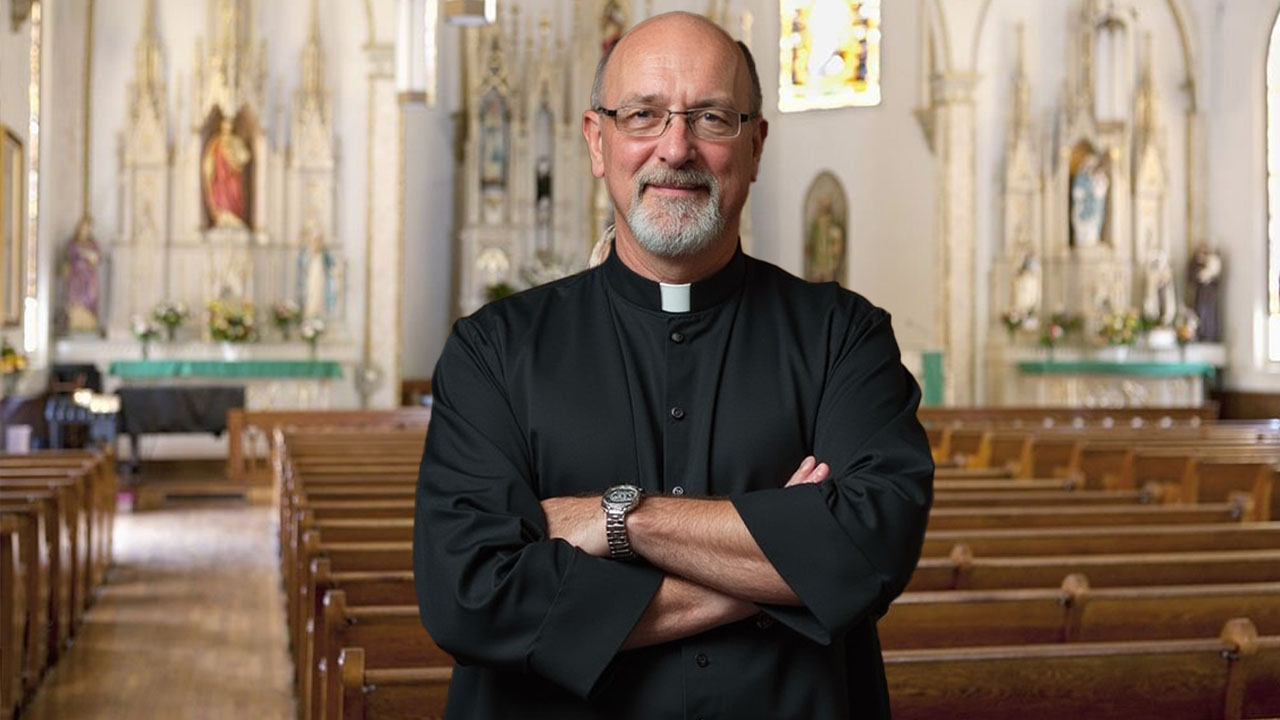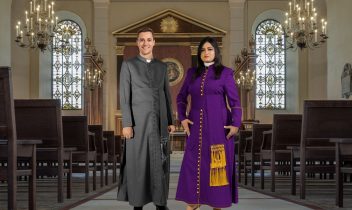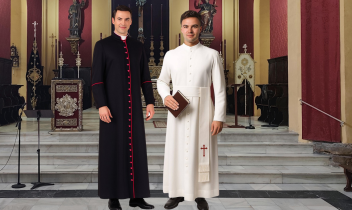No products in the cart.
Return To Shop
Have you ever been curious about the distinctive clothing worn by nuns or reflected on the Catholic Priest Dress and Its Importance in Worship? Though their garments may appear simple, each piece carries deep meaning and is steeped in tradition.
The attire of a priest is not just a set of garments; it’s a powerful visual symbol of their sacred role and spiritual commitment. From the long, black cassock that symbolizes humility to the colorful chasuble that reflects Christ’s sacrifice, every piece of the priest’s dress carries profound meaning.
These garments are not chosen for their appearance alone, but to represent the deep traditions and spiritual duties of the priesthood. Imagine stepping into a church where every piece of clothing worn by the priest serves a higher purpose.
The cassock, worn daily, marks the priest’s separation from worldly concerns, while the stole and chasuble worn during Mass signify their authority and role in the sacrament. Each element speaks to a history of faith that spans centuries.
In this article, we will explore the symbolic meaning behind the dress of priest and why it remains so significant in both historical and Priest outfit parts also modern times. We’ll uncover the layers of meaning behind these iconic garments and show how they continue to shape the role of the priest in today’s Church
What is the Priest’s Dress Called?
The priest’s dress refers to the distinctive garments worn by clergy, each serving a specific role in both daily life and religious ceremonies. The primary piece of attire is the cassock, a long, black robe that symbolizes humility, devotion, and separation from the secular world. It is worn by priests both during their day-to-day activities and at various liturgical events.
When it comes to Mass or other formal services, the catholic priest dress for mass includes additional garments that reflect the priest’s sacred role:
- Chasuble: A large, flowing garment worn over the cassock, typically during Mass, symbolizing the priest’s role in Christ’s sacrifice. The color of the chasuble changes depending on the liturgical season.
- Stole: A narrow strip of cloth draped over the shoulders, worn around the neck to symbolize the priest’s authority and the grace of the Holy Spirit.
- Surplice: A white, often loose garment worn over the cassock, typically in non-Eucharistic settings or during choir services, symbolizing purity and holiness.
Together, these garments form the complete priest dress name, essential for religious rituals and the priest’s role in administering sacraments and leading the congregation. These catholic priest dress names are rich in symbolism, emphasizing a priest’s spiritual commitment and distinctive duties within the Church.
The Symbolism Behind the Dress of a Priest
The symbolism behind the dress of a priest carries deep meaning, rooted in tradition and the priest’s spiritual role. Each piece of the priest’s attire is not just for practical use; it symbolizes specific aspects of faith, humility, and service to God.
- Cassock: The black cassock, a long robe worn daily by priests, represents humility and a life devoted to God. The color black is often associated with simplicity and detachment from worldly desires, signaling the priest’s focus on spiritual matters rather than secular concerns.
- Chasuble: Worn over the cassock during Mass, the chasuble symbolizes the priest’s role in offering Christ’s sacrifice. Its color changes depending on the liturgical season, such as purple for repentance (Lent), red for martyrs, or white for festive occasions like Christmas or Easter, reflecting the different aspects of the Church year.
- Stole: The stole, worn around the neck, signifies the priest’s spiritual authority. It is a symbol of the faith. It reflects the priest’s connection to Christ, who is the true source of authority in the Church.
- Surplice: Often worn over the cassock during non-Eucharistic services or choir events, the surplice is a symbol of purity and holiness. Its white color represents the priest’s commitment to a life of purity and service to God.
Each of these garments plays a vital role in helping the priest live out his vocation, guiding him in his service to the Church while also distinguishing him as someone set apart for sacred duties. The priest’s dress isn’t just for show; it’s a visual and symbolic reminder of his calling and the sacred nature of his work.
Why do priests wear dresses?
Priests wear distinctive garments, commonly referred to as “dresses” in casual conversation, for several significant reasons, deeply rooted in faith, tradition, and liturgical practice. These garments are not just about appearance; they serve as symbols of a priest’s spiritual role and dedication.
Symbol of Humility and Devotion:
The priest’s attire, especially the cassock, represents a life of humility and service to God. By wearing a simple, consistent outfit, priests visually demonstrate their commitment to a life set apart from worldly distractions, focusing entirely on their spiritual responsibilities.
Spiritual Authority and Identification:
The clothing of a priest also signifies his role within the Church, marking him as a spiritual leader. These garments help the congregation recognize the priest’s sacred position, emphasizing his responsibility to guide and lead worship. The attire is a visual marker of the priest’s authority, marking him as someone who serves as an intermediary between God and the people.
Liturgical Significance:
The various pieces of priestly dress, like the chasuble, stole, and surplice, all have rich meanings related to the rituals of the Church. The chasuble worn during Mass, for example, symbolizes the priest’s participation in the sacrifice of Christ, while the stole represents the priest’s spiritual authority to administer sacraments. These garments are designed to enhance the reverence of religious ceremonies, ensuring the focus remains on the sacred nature of the worship.
Tradition and Continuity:
The custom of wearing specific priestly attire is steeped in history. By maintaining these traditional garments, priests connect with centuries of clergy who have come before them. The continuity of these garments not only honors the Church’s past but also preserves the sacredness of the role across generations.
In conclusion, the “dress” of a priest is not simply clothingit is a visual and symbolic expression of his commitment, authority, and devotion. It helps to distinguish him as someone dedicated to sacred service, while also honoring the rich tradition and spiritual significance embedded in the attire.
What is Choir Dress for Clergy?
In addition to the priest dress for Mass, there’s also the concept of choir dress. This refers to the attire worn by clergy members, especially in liturgical settings like choir services or non-Eucharistic events. The surplice is commonly worn as part of choir dress, symbolizing purity. It is often paired with a cassock to complete the look, especially for those leading hymns or singing in a liturgical choir.
Though choir dress for clergy is less formal than the full priest dress for Mass, it still carries religious symbolism. These garments focus on the priest’s sacred role within the Church but are designed for different types of services.
How to Dress Like a Priest
If you want to respectfully dress in traditional priest attire, here’s a simple breakdown of the essentials and what each piece represents:
- Cassock: The cassock is a long robe, often black for priests, purple for bishops, and red for cardinals, symbolizing humility and spiritual dedication. It’s the core garment, serving as the main robe beneath other layers.
- Surplice: The surplice is a white, loose-fitting garment worn over the cassock. It is usually decorated with lace or simple designs and represents purity. It is often used for services outside of Mass.
- Stole: Draped around the neck and often color-coded to reflect the liturgical season, the stole signifies the priest’s authority and role in sacraments. It’s worn both in and outside of Mass.
- Chasuble: For celebrating Mass, priests wear the chasuble, an outer layer that’s color-coordinated with the liturgical calendar, like green for Ordinary Time or purple for Lent. This garment reflects the priest’s role in the Eucharist
- Optional Accessories: For a complete look, additional accessories can include a biretta (square hat) or a zucchetto (skullcap), often worn by higher-ranking clergy.
Each item serves a purpose and carries symbolic meaning, representing dedication to faith and the community.
The Dress Does Not Make the Priest
While the priest dress is iconic and important, it’s crucial to remember that the dress does not make the priest. A priest’s true identity and worth are not found in their attire but in their dedication to serving God and their community. These garments are tools to help priests fulfill their sacred calling, but their true role is defined by their faith, service, and the way they live out their vocation.
Frequently Asked Questions (FAQs)
What is a priest’s dress called?
The primary garment worn by priests is the cassock, and additional items like the chasuble, stole, and cincture complete the attire.
Why do priests wear dresses during Mass?
The garments worn during Mass symbolize humility, service, and authority, helping create an atmosphere of reverence and respect for the sacrament.
How can I dress like a priest?
To dress like a priest, you need a cassock, stole, cincture, and a surplice. These items can be found at stores specializing in clergy garments.
Is it illegal to dress as a priest?
Dressing as a priest in certain contexts may be considered disrespectful or even illegal if done to deceive or impersonate. It’s important to be mindful of the setting and purpose.
Where can I buy clergy attire?
If you are looking to purchase a Catholic priest dress or other clergy garments, consider visiting Clergy Wear Shop, your trusted online store for high-quality clergy attire and accessories.








Recent Comments